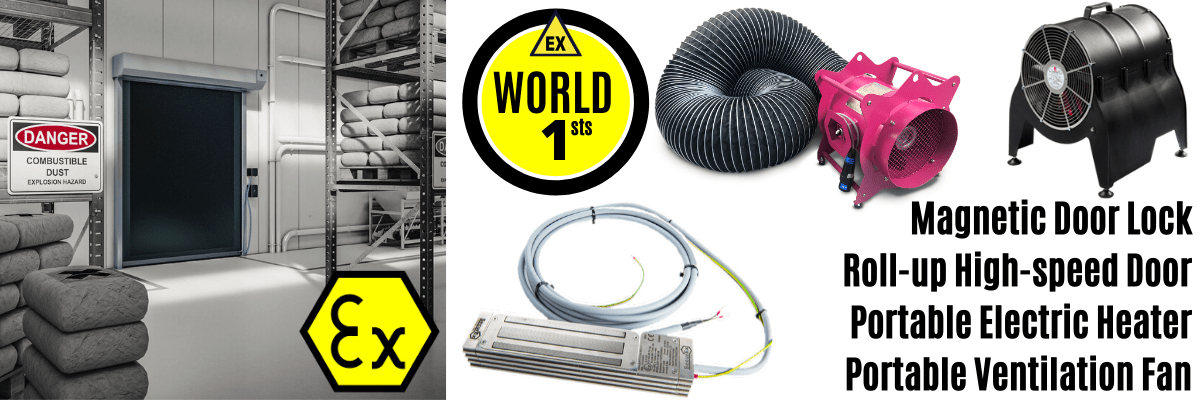ATEX Safety | Static Ignition & Thermal Instability
Published 06 Jan 2021
A Series of Articles to educate and inform those involved in the Hazardous Area & Explosive Atmosphere industries.
This Article is number 5 of 8 in the ATEX Safety & Explosive Atmospheres series.
Republished with the kind permission of Declan Barry, Managing Director of ATEX Explosion Hazards Ltd.
Also in association with INBUREX Consulting.
Declan Barry has an objective to make the industry safe by installing the  appropriate explosion protection solutions to industry with full back up services. With 42 years of experience providing Explosion Hazard Services to the process industry, ATEX Explosion Hazards Ltd have a wide range of expertise within their group of companies.
appropriate explosion protection solutions to industry with full back up services. With 42 years of experience providing Explosion Hazard Services to the process industry, ATEX Explosion Hazards Ltd have a wide range of expertise within their group of companies.

This is the fifth in a series of eight articles, which aim to help you establish a simple basis of safety in your plant and dispel some of the myths associated with process and safety risk assessments.
ATEX Safety
Static Ignition & Thermal Instability
Static electricity is part of everyday life and is generated when materials come in to contact with each other and then separate i.e. electrostatic charging occurs at the interface. The phenomenon is known as a ‘contact electrification’ and this gives rise to a ‘streaming’ or charging current.
Potential electrostatic charging hazards are shown in the following images and include fluid ow in pipework, drum charging operations, walking across a floor, pouring powders, film transport rollers, spraying, etc.


The electric field produced can give rise to different types of discharge, with differing energy levels. The highest charging currents arise from the use of electrically insulating materials (e.g. PTFE lined equipment, Poly-Tubs, plastic sheeting and insulating (low conductivity) liquids such as Toluene, n-Hexane and many others.

Operatives isolated from earth via their footwear or the flooring can become charged unknowingly, simply by standing within an electrostatic field.
For example, at rest, humans are likely to be charge neutral i.e. no significant excess positive or negative charge. However, if they stand next to a highly charged surface (e.g. negatively charged FIBC), the charges on their body will ‘polarise’ i.e. the residual negative charges will be repelled and the positive charges attracted. Whilst in this position, if the person touches an earthed item, the free (negative) charges will ow to earth and as he or she walks away, they will be left with net positive charge, which is a potential source of static ignition.
Charge generation per se is not the issue; the problem is the accumulation of charge because it can create a source of static ignition.

The most basic precaution against electrostatic ignition is earthing – the structure of the plant and associated vessels/equipment are a potential source of electrostatic charge accumulation and therefore, must be earthed to avoid this risk.
 All metal items and fittings (e.g. funnels, metal spirals in flexible LEV trunking, etc.) should be in good contact with each other and with earth. For example, Blo-line / Morris couplings have an integral earthing strip (as shown in the photo above) to ensure electrical continuity through the coupling and along the pipework.
All metal items and fittings (e.g. funnels, metal spirals in flexible LEV trunking, etc.) should be in good contact with each other and with earth. For example, Blo-line / Morris couplings have an integral earthing strip (as shown in the photo above) to ensure electrical continuity through the coupling and along the pipework.
Electrical continuity checks should be made before equipment is brought into use and following any maintenance work.
Frequently, however, earthing failures are evident during audits e.g. unattached / ungrounded metal reinforcing helices in flexible trunking, grilles in loading chutes, etc.
The requirements for resistance levels are essentially those normally used by electrical engineers i.e. LESS THAN 10 to earth. In practice, higher resistances may be used (up to 106 Ω) but only where the reason for the high resistance is known and controlled.
Static Ignition
Types Of Discharge

Spark: Occurs between two conductors (the plasma
channel is over the entire gap)

Corona: Point discharge with no plasma channel

Brush: Occurs between a charged non-conducting
surface and a (rounded) earthed conductor or
electrode

Propagating Brush: Polarised insulating sheets of
very high charge density

Cone: Occurs from highly charged, high resistivity
granular materials
People
People who are insulated from earth (by their footwear or the flooring) can easily acquire and retain an electrostatic charge. If the MIE of the flammable atmosphere is lower than 30 mJ, consideration needs to be given to grounding personnel i.e. use of ‘charge dissipative’ footwear and flooring. In addition, clothing should be as close fitting and should not be removed or unfastened within the hazardous area.
Insulating Plastics
Insulating plastics can present a risk of static ignition in zoned areas, also. ‘Brush discharges’ with energies up to 4 mJ can occur from charged insulating surfaces and this is well in excess of the minimum required for static ignition of low ash point solvents (e.g. Acetone, Toluene, Methanol, etc.) and sensitive airborne powders.
Thus, the exposed surface areas of insulating surfaces need to be restricted, as shown below.
Restrictions on Surface Area (cm2) – Sheets
| Gas type G | Group IIA | Group IIB | Group IIC |
| 0 | 50 | 25 | 4 |
| 1 | 100 | 100 | 20 |
| 2 | No limit | No limit | No limit |
For example, high resistivity plastics exceeding 100 sq.cm in area cannot be used with IIA or IIB solvents in Zone 1 areas, unless it can be shown that charge generation (or incendive discharges) will not arise even in the case of likely malfunctions. Clearly, this excludes all but the smallest of plastic items.

To preclude highly energetic ‘propagating brush discharges’, special types of FIBC are required. Type A bags (which have no dissipative properties and high breakdown strengths) should NOT be used with explosible powders.
- A – No special requirements
- B – Breakdown FIBC wall < 4 kV
- C – Resistance to earth from any location <
100 M.Ω - D – Interwoven conductive threads not
connected together
Thus, an electrostatic hazard assessment requires a systematic study of where (and the levels of) charge that can be generated, whether it can accumulate, the type and energy of the discharge and the ignition sensitivity of the flammable atmosphere.
Thermal instability
General guidance for risk control is specified in DSEAR Section 6.4 (Risk Reduction) and one of the key elements is ‘Avoid Adverse Conditions’ Essentially, in heated equipment such as Dryers, Hot Boxes, etc.), this relates to the identification and control of areas where hot dry material can collect (Dryer inlets/outlets, Mechanical Conveyors, Mills, etc.).
In most cases, small scale tests such as DTA or DSC? will not be sufficient; Diffusion Cells, Aerated Cell or Air Over Layer tests are preferred since the availability of air during self-heating can have a profound effect. The key features are the onset temperature of self heating Tonset, the points at which the exotherm becomes marked Tmarked (> 5 K/min) and rapid Trapid (> 50 K/min).
Thermal stability test results can indicate significant self-heating hazards e.g. smouldering nests inside bulked product, smoulders on ledges inside Dryers, etc. Some materials exhibit relatively low exotherm onset temperatures from about 130 ºC and high peak temperature of > 700 ºC, even on the small scale.

However, these tests are still for screening purposes because they don’t allow the effect of scale to be determined. Where exothermic activity near the process operating temperature is likely, further ‘Basket Tests’ will be required to allow safe operating temperatures to be quantified. The tests are run isothermally in wire baskets of different size.
The effect of scale is predicted by plotting scale (volume/surface area) against the reciprocal self-heat temperature TC (K). An example is given as follows:

The self-heat onset temperature will increase as the surface area of the bulked material increases. For example, if a material starts to self-heat at 93 ºC as a 1 m3 mass, thermal predictions may show that as a 50 cm thick layer, the onset would be nearer 107 ºC due to greater cooling by the larger surface area.
Thermal instability can also occur in fibrous insulation. The potential static ignition / re hazard arises from auto-oxidation of insulation – a gradual exothermic oxidation of combustible material, accompanied by the generation of heat. Hence, auto-oxidation needs to be controlled whenever there is a possibility of insulation being contaminated, particularly by oils at elevated temperatures

Auto-oxidation and escalation in temperature is exacerbated by the inherent insulation (low thermal conductivity) properties and high surface area. Hence, it is often prudent to use a closed-cell type of insulation on hot oil systems, particularly around joints, known leakage points, etc. since this type of insulation is not prone to oil seepage or wetting.
NOTE: Great care is needed when removing contaminated lagging as this too can spontaneously ignite. Oil contaminated lagging should be removed only under a HOT WORK permit.
More Explosion Hazards Articles
- ATEX Safety | Establishing A Basis Of Safety In Explosive Atmospheres
- ATEX Safety | Characterising Material Hazards
- ATEX Safety | Hazardous Area Classification
- ATEX Safety | Potential Sources of Ignition
- ATEX Safety | Prevention
- ATEX Safety | Protection
- ATEX Safety | Management Procedures

EXPERTS IN EQUIPMENT FOR EXPLOSIVE ATMOSPHERES
LEADERS IN ATEX INNOVATION TO THE HAZARDOUS AREA INDUSTRIES
Thorne & Derrick are leaders in the development and distribution of Product Innovations that deliver significant improvements to clients plant, people and operational safety in the explosive atmosphere industries.
Your proactive problem solvers experienced in succession planning for the replacement of obsolete, non-conformant and legacy equipment in hazardous areas.
Your first-choice provider of innovative and competitive solutions to ensure ATEX & IECEx Compliance for Hazardous Area Electrical, HVAC & Process Instrumentation Equipment to UK and international projects.
Control Panels | Plugs | Isolators | Enclosures & Junction Boxes | Lighting | Control Stations | Motor Starters | Heat Trace | Gas Detection | Flame Detection | Process Instrumentation | Process Heating | Ventilation Fans | Security Access Control

Competitive Prices | Extensive Stocks | Technical Support | Express Delivery







